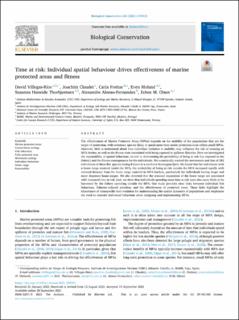| dc.contributor.author | Villegas-Ríos, David | |
| dc.contributor.author | Claudet, Joachim | |
| dc.contributor.author | Freitas, Carla | |
| dc.contributor.author | Moland, Even | |
| dc.contributor.author | Thorbjørnsen, Susanna Huneide | |
| dc.contributor.author | Alonso-Fernández, Alexandre | |
| dc.contributor.author | Olsen, Esben Moland | |
| dc.date.accessioned | 2021-10-04T09:01:01Z | |
| dc.date.available | 2021-10-04T09:01:01Z | |
| dc.date.created | 2021-09-30T15:56:14Z | |
| dc.date.issued | 2021 | |
| dc.identifier.citation | Biological Conservation. 2021, 263 . | en_US |
| dc.identifier.issn | 0006-3207 | |
| dc.identifier.uri | https://hdl.handle.net/11250/2787397 | |
| dc.description.abstract | The effectiveness of Marine Protected Areas (MPAs) depends on the mobility of the populations that are the target of protection, with sedentary species likely to spend more time under protection even within small MPAs. However, little is understood about how individual variation in mobility may influence the risk of crossing an MPA border, as well as the fitness costs associated with being exposed to spillover fisheries. Here we investigated the repeatability of spatial behaviour, its role in determining the probability of being at risk (i.e. exposed to the fishery) and the fitness consequences for the individuals. We acoustically tracked the movements and fate of 282 individuals of three fish species during 8 years in a southern Norwegian fjord. We found that for individuals with a home range centroid inside the MPA, the probability of being at risk outside the MPA increased rapidly with reduced distance from the home range centroid to MPA borders, particularly for individuals having larger and more dispersed home ranges. We also detected that the seasonal expansions of the home range are associated with increased time at risk. Last, we show that individuals spending more time at risk were also more likely to be harvested by the fishery operating outside the MPA. Our study provides clear links between individual fish behaviour, fisheries-induced selection, and the effectiveness of protected areas. These links highlight the importance of intraspecific trait variation for understanding the spatial dynamics of populations and emphasize the need to consider individual behaviour when designing and implementing MPAs. | en_US |
| dc.language.iso | eng | en_US |
| dc.title | Time at risk: individual spatial behaviour drives fitness and marine protected area effectiveness | en_US |
| dc.type | Peer reviewed | en_US |
| dc.type | Journal article | en_US |
| dc.description.version | publishedVersion | en_US |
| dc.source.pagenumber | 11 | en_US |
| dc.source.volume | 263 | en_US |
| dc.source.journal | Biological Conservation | en_US |
| dc.identifier.doi | 10.1016/j.biocon.2021.109333 | |
| dc.identifier.cristin | 1941591 | |
| dc.relation.project | Norges forskningsråd: 294926 | en_US |
| dc.relation.project | EC/H2020/793627 | en_US |
| cristin.ispublished | true | |
| cristin.fulltext | original | |
| cristin.qualitycode | 2 | |
